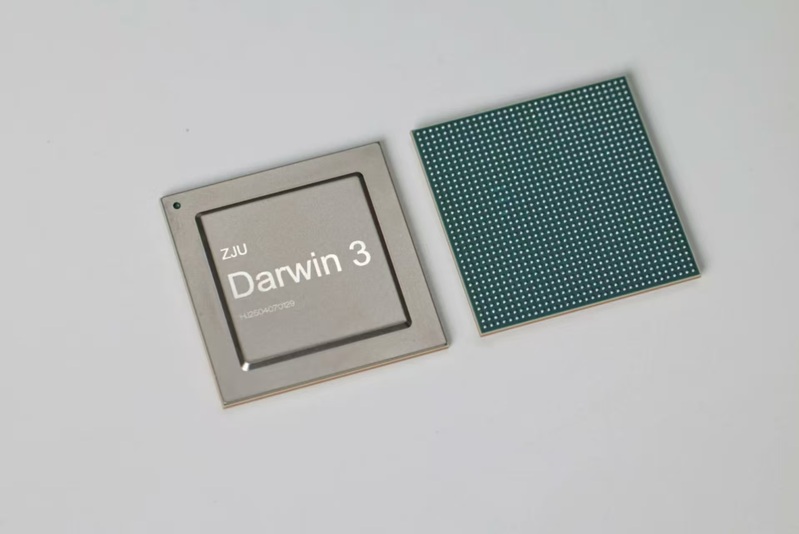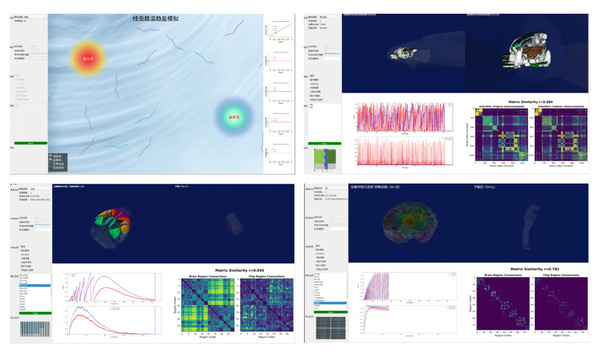World’s first 2-billion-neuron brain-inspired computer unveiled by ZJU
In a breakthrough that pushes the boundaries of artificial intelligence and neuroscience, researchers at Zhejiang University have unveiled Darwin Monkey (“Wukong”) — the world’s first brain-inspired computer powered by a dedicated neuromorphic chip with more than two billion neurons. The achievement positions China at the forefront of global neuromorphic computing research.
From brain to machine
The human brain is an extraordinary efficient computing system, capable of integrating vision, hearing, language, learning, reasoning, decision-making, and planning. Brain-inspired computing applies the operating mechanisms of biological neural networks to computer system design, creating low-power, highly parallel, efficient, and intelligent computing systems similar to the brain.
“Wukong” marks a major leap in this field. It consists of 15 blade-type neuromorphic servers, each containing 64 Darwin-III chips. Its neuron count approaches that of a macaque brain. Under typical operating conditions, it consumes just 2,000 watts, remarkably low given its scale.

The Darwin-III chips
The Darwin-III chip, jointly developed by Zhejiang University and Zhijiang Laboratory in early 2023, supports more than 2.35 million spiking neurons and over 100 million synapses per chip. It also features a custom instruction set for brain-inspired computing and supports real-time online learning.
This builds on the team’s earlier success: in September 2020, they launched Darwin Mouse (“Mickey”), China’s first brain-inspired computer exceeding 100 million neurons.
Breaking hardware bottlenecks
To overcome limitations in inter-chip communication and energy efficiency, the team collaborated with the College of Integrated Circuits, Zhejiang University to develop the Darwin Wafer — an ultra-integrated, wafer-level brain-inspired chip built using advanced 2.5D CoWoS-S packaging technology.
The result is a System-on-Wafer (SoW) blade server whose core is a single 12-inch wafer integrating 64 Darwin-III chip dies. This design bypasses the physical constraints of traditional printed circuit boards, enabling micron- and nanometer-scale optimization of signal interconnections.

Brain-like operating system
Engineering breakthroughs
Over more than two years, the researchers achieved multiple technical firsts:
- Scalable architecture: A large-scale neuron interconnection framework using multidimensional grid topology for hierarchical, expandable chip-to-chip communication.
- Adaptive timing: A dynamic time-step control mechanism to coordinate tasks across vast neuron networks.
- Wafer-level integration: Domestic wafer manufacturing combined with advanced 2.5D packaging to enable high-density neuromorphic integration.
- Smart resource management: A multi-tier system for scheduling and memory optimization across massive neuron systems.
To harness this hardware’s potential, the team built a next-generation Darwin brain-inspired operating system. It employs load-aware scheduling and dynamic time-slicing to efficiently allocate resources while considering communication bandwidth and task profiles.
Smarter applications, deeper science
On “Wukong,” the team has successfully deployed several advanced applications. The system runs the DeepSeek brain-inspired large model, capable of logical reasoning, content generation, and solving mathematical problems. It can also simulate the brains of animals, such as Caenorhabditis elegans, zebrafish, mice, and macaques at different neuron scales, offering neuroscientists a powerful new tool for neuroscience research.

Simulations of the brains of C. elegans, zebrafish, mice, and macaques
Shaping the future of AI and neuroscience
The launch of the “Wukong” brain-inspired computing system represents a new computing paradigm for existing scenarios:
- A next-generation AI engine: Brain-inspired systems could tackle the high energy and computational demands of deep learning and large models, while online, unsupervised learning could transform AI adaptability.
- A living laboratory for brain research: As a natural brain simulator, “Wukong” offers neuroscientists a high-fidelity platform for studying brain mechanisms without invasive biological experiments.
- A stepping stone toward Artificial General Intelligence (AGI): By emulating the brain’s reasoning processes while surpassing its raw processing speed, “Wukong” could accelerate the path toward truly human-like AI.
With “Wukong,” we are not only building faster computers, but we are also exploring a new way of computing. This is about understanding the brain, advancing AI, and rethinking how machines can learn.
Translator: FANG Fumin
Editor: HE Jiawen, ZHU Ziyu